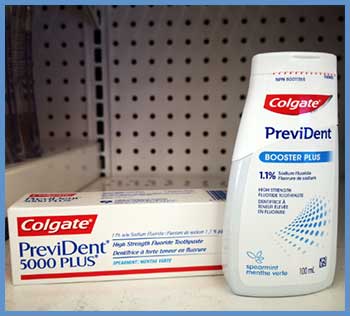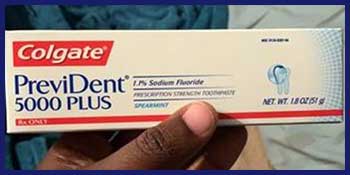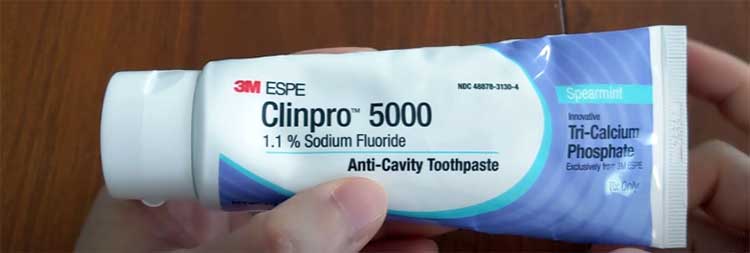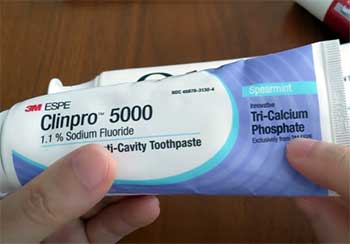As someone who’s always been a bit obsessive about dental health, I’ve spent countless hours researching ways to keep my teeth strong and cavity-free. When my dentist recommended prescription toothpastes like PreviDent and ClinPro, I was curious but skeptical.
Could these really make a difference compared to my trusty drugstore brand? In this article, I’ll compare PreviDent and ClinPro, breaking down their key features, pros, and cons to help you decide which might be the best fit for your smile.
Let’s explore what makes these dental heavyweights tick and how they can protect your teeth.
A Brief Comparison Table
| Feature | PreviDent 5000 Plus | ClinPro 5000 |
| Active Ingredient | 1.1% Sodium Fluoride | 1.1% Sodium Fluoride |
| Additional Ingredients | None | Tri-Calcium Phosphate (TCP) |
| Purpose | Cavity prevention | Cavity prevention, remineralization |
| Potassium Nitrate | No (except in Sensitive variant) | No (except in ClinPro 5000 Sensitive) |
| SLS-Free Option | Yes (Dry Mouth variant) | Yes |
| Flavor | Spearmint, Fruitastic | Vanilla Mint |
| Application Method | Brush, optional tray | Brush, optional tray |
| Prescription Required | Yes | Yes |
| Cost (Approx.) | $15–$25 per tube | $15–$25 per tube |
| Availability | Pharmacy, dental offices | Pharmacy, dental offices |
My Journey With Prescription Toothpastes
I’ve always taken my dental routine seriously—flossing daily, rinsing with mouthwash, and brushing twice a day. But a few years ago, my dentist noticed early signs of enamel wear and suggested I step up my game with a prescription toothpaste.
That’s when I first heard about PreviDent and ClinPro. Both are high-strength fluoride toothpastes designed to fight cavities and strengthen enamel, but they’re not your average over-the-counter options.
I wanted to know which one would best suit my needs, so I dug into their ingredients, effectiveness, and real-world performance.
What Is PreviDent?

PreviDent, made by Colgate, is a line of prescription toothpastes with a hefty 1.1% sodium fluoride concentration—about five times stronger than your typical drugstore toothpaste.
This high fluoride content is the star of the show, working to prevent cavities by strengthening enamel and making teeth more resistant to acid attacks from plaque and sugary foods.
PreviDent comes in several variants, like 5000 Plus, Booster Plus, Enamel Protect, Sensitive, and Dry Mouth, each tailored to specific dental needs.
I tried PreviDent 5000 Plus first because my dentist recommended it for cavity prevention. The spearmint flavor was pleasant, not too overpowering, and it left my mouth feeling clean.
I noticed it didn’t foam as much as regular toothpaste, which took some getting used to. My dentist also suggested using it in a custom tray for a few minutes daily to maximize fluoride absorption, but I stuck to brushing since trays felt like too much hassle.
What Is ClinPro?

ClinPro 5000, produced by 3M, also packs 1.1% sodium fluoride but adds a unique ingredient: tri-calcium phosphate (TCP). This combo is designed not just to prevent cavities but to actively remineralize early white spot lesions—those chalky patches that signal the start of enamel breakdown.
ClinPro’s TCP is encapsulated in a protective barrier during manufacturing, which breaks down in saliva to release calcium, phosphate, and fluoride directly onto your teeth. This teamwork helps rebuild enamel more effectively than fluoride alone.
When I switched to ClinPro 5000, I noticed its vanilla mint flavor was milder than PreviDent’s. It felt smoother on my teeth, almost like a gentle polish.
My dentist explained that the TCP could give ClinPro an edge for patients like me, who had a history of orthodontic treatment and were prone to white spots from plaque buildup around braces.
Key Features of PreviDent
PreviDent’s strength lies in its simplicity and versatility. Here’s what stands out:

- High Fluoride Content: The 1.1% sodium fluoride is the backbone, delivering a robust defense against cavities. It’s ideal for people at high risk of tooth decay, like those with a history of cavities or orthodontic work.
- Multiple Variants: PreviDent offers tailored options. The Sensitive variant includes 5% potassium nitrate to ease tooth sensitivity, while the Dry Mouth version skips sodium lauryl sulfate (SLS), a foaming agent that can irritate those with dry mouth or oral ulcers.
- Flexible Application: You can brush with PreviDent or use it in a dental tray for deeper fluoride penetration, which is great for severe cases of enamel wear.
- Widely Available: As a Colgate product, PreviDent is easy to find at pharmacies and dental offices.
I appreciated how straightforward PreviDent was. It didn’t promise fancy extras—just powerful fluoride to keep cavities at bay. The Dry Mouth variant was a game-changer for a friend who struggled with irritation from regular toothpastes.
Pros of PreviDent
- Proven Effectiveness: PreviDent’s high fluoride concentration is backed by decades of research showing it reduces cavity risk significantly. Studies, like one from the National Library of Medicine, confirm its ability to reverse early root caries.
- Variety of Options: With variants for sensitivity, dry mouth, and enamel protection, PreviDent caters to diverse needs. I liked having choices based on my specific dental concerns.
- Trusted Brand: Colgate’s reputation adds confidence. I felt secure knowing a well-known company stood behind the product.
- Cost-Effective: Priced between $15–$25 per tube, it’s comparable to ClinPro and often covered by dental insurance.
- Flexible Use: Brushing or tray application gives you options, which is great if you want to customize your routine.
Cons of PreviDent
- No Additional Remineralizing Agents: Unlike ClinPro, PreviDent relies solely on fluoride. If you have early white spot lesions, it might not be as effective at rebuilding enamel.
- Taste Variability: Some users, including me, found the Fruitastic flavor a bit too sweet, and the spearmint can feel medicinal.
- Potential for Fluorosis: Swallowing too much PreviDent, especially in kids, can lead to fluorosis—white spots or discoloration on teeth. I was careful to spit thoroughly after brushing.
- Prescription Barrier: You need a dentist’s prescription, which can be inconvenient if you don’t have easy access to dental care.
- Limited Sensitivity Relief: Only the Sensitive variant addresses tooth sensitivity, so you might need to buy multiple products if you have varied needs.
Key Features of ClinPro

ClinPro takes a more complex approach with its formula. Here’s what makes it unique:
- Tri-Calcium Phosphate (TCP): This ingredient sets ClinPro apart. TCP works with fluoride to remineralize enamel, targeting white spot lesions and early decay. It’s especially helpful for patients with orthodontic history or early enamel damage.
- High Fluoride Content: Like PreviDent, ClinPro uses 1.1% sodium fluoride for cavity prevention.
- SLS-Free Formula: ClinPro avoids SLS, making it gentler for people with dry mouth or sensitivity to foaming agents.
- Single Flavor Profile: The vanilla mint flavor is consistent across ClinPro 5000, keeping things simple but less varied than PreviDent’s options.
Using ClinPro felt like giving my teeth an extra layer of armor. The idea of rebuilding enamel with TCP was appealing, especially since I’d had braces as a teen and worried about lingering weak spots.
Pros of ClinPro
- Enhanced Remineralization: The addition of TCP gives ClinPro an edge in repairing early enamel damage. A study showed ClinPro 5000 improved surface hardness by 12.7 units in white spot lesions, though not significantly better than other agents.
- Gentle Formula: Being SLS-free makes it ideal for people with dry mouth or oral sensitivities. I noticed less irritation compared to some foaming toothpastes.
- Effective for Orthodontic Patients: ClinPro’s TCP targets white spot lesions common after braces, which was a big plus for me.
- Pleasant Flavor: The vanilla mint taste is mild and universally appealing, avoiding the medicinal aftertaste of some prescription toothpastes.
- Comparable Cost: Like PreviDent, ClinPro costs $15–$25 per tube, making it accessible for prescription toothpaste.
Cons of ClinPro
- Single Variant: Unlike PreviDent, ClinPro 5000 doesn’t offer specialized versions for sensitivity or dry mouth, though a Sensitive version exists with limited availability.
- Prescription Required: Like PreviDent, you’ll need a dentist’s approval, which can be a hassle.
- Less Brand Recognition: 3M isn’t as synonymous with dental care as Colgate, which might make some users hesitant.
- Mild Flavor: While I liked the vanilla mint, some might find it too subtle, craving a stronger mint kick.
- Limited Research Edge: While TCP is promising, studies show ClinPro’s remineralization benefits aren’t always statistically significant over other high-fluoride toothpastes.
My Experience Comparing The Two

Switching between PreviDent and ClinPro was an eye-opener.
PreviDent felt like a reliable workhorse—simple, effective, and backed by a brand I trusted.
Its high fluoride content gave me confidence that my cavity-prone teeth were protected.
However, I noticed no dramatic changes in the faint white spots from my braces days. ClinPro, on the other hand, felt like a high-tech upgrade. The TCP addition made me hopeful about repairing those spots, and the smoother texture was a nice bonus.
After a few months, my dentist noted slight improvements in enamel strength with ClinPro, but nothing life-changing.
Both toothpastes require a prescription, so I had to plan ahead to refill them. Cost-wise, they were neck-and-neck, with prices varying slightly by pharmacy. I paid about $18 for PreviDent and $20 for ClinPro, but insurance covered most of it.
The biggest difference came down to my goals: PreviDent for straightforward cavity prevention, ClinPro for tackling early enamel damage.
Who Should Use PreviDent?
PreviDent is a great choice if you’re focused on cavity prevention and want a trusted, versatile option. It’s ideal for:
- People with a high risk of cavities due to diet, genetics, or past dental work.
- Those with sensitive teeth or dry mouth, thanks to its specialized variants.
- Anyone who prefers a well-known brand like Colgate for peace of mind.
I’d recommend PreviDent to someone who wants a no-frills, fluoride-heavy toothpaste and doesn’t need extra remineralization support. It’s a solid pick for maintaining strong teeth.
Who Should Use ClinPro?
ClinPro shines for those dealing with early enamel damage or white spot lesions, especially post-orthodontic patients. It’s best for:
- People with a history of braces or aligners, where white spots are common.
- Those seeking a gentler, SLS-free formula to avoid irritation.
- Patients interested in remineralization beyond fluoride’s capabilities.
If you’re like me and worry about lingering enamel weaknesses, ClinPro’s TCP formula feels like a targeted solution. It’s a bit more specialized but worth considering for specific needs.
How To Choose Between PreviDent And ClinPro?
Choosing between PreviDent and ClinPro depends on your dental goals. If cavities are your main concern and you want a straightforward, proven option, PreviDent’s high fluoride content and variety of formulations make it a safe bet.
Its variants let you address sensitivity or dry mouth without switching brands. However, if you’re dealing with early white spot lesions or want a toothpaste that actively rebuilds enamel, ClinPro’s TCP gives it an edge. Its SLS-free formula is also a plus for sensitive mouths.
I found that talking to my dentist was key. She reviewed my dental history—braces, occasional sensitivity, and a sweet tooth—and leaned toward ClinPro for its remineralization potential.
But she also said PreviDent would work well if I preferred its flavor or needed the Sensitive variant. Your dentist can help you weigh your needs and lifestyle.
Practical Tips For Using Prescription Toothpastes
Using PreviDent or ClinPro effectively takes a bit of know-how. Here’s what I learned:
- Brush Properly: Use a pea-sized amount and brush for two minutes. Spit, don’t rinse, to let the fluoride sit on your teeth longer.
- Nighttime Routine: Both work best when used before bed, as saliva flow slows overnight, allowing longer contact with teeth.
- Tray Option: If your dentist suggests a tray, apply a thin layer of toothpaste and wear it for 5–10 minutes. I skipped this, but it’s great for severe cases.
- Avoid Overuse: Too much fluoride can cause fluorosis, especially in kids. Stick to the prescribed amount.
- Check with Insurance: Both are often covered, but confirm with your provider to avoid surprise costs.
Frequently Asked Questions (FAQ)
No, they’re not identical. Both have 1.1% sodium fluoride for cavity prevention, but ClinPro includes tri-calcium phosphate (TCP) for enhanced remineralization, while PreviDent offers more specialized variants like Sensitive and Dry Mouth.
Yes, ClinPro 5000 is stronger than regular toothpaste, with 1.1% sodium fluoride versus 0.2–0.3% in over-the-counter brands. Its TCP also supports enamel repair, making it more effective for high-risk patients.
No, ClinPro 5000 doesn’t have a direct generic equivalent due to its unique TCP formulation. However, other high-fluoride toothpastes, like PreviDent, may be suggested as alternatives by your dentist.
PreviDent strengthens enamel through fluoride, which promotes remineralization of early decay. However, it doesn’t contain additional agents like ClinPro’s TCP, so its enamel repair is less targeted.
Conclusion: Your Smile, Your Choice
Navigating the world of prescription toothpastes like PreviDent and ClinPro can feel overwhelming, but it’s all about finding what works for you. I’ve shared my experience to help you weigh their strengths—PreviDent’s versatility and proven fluoride power versus ClinPro’s innovative TCP for enamel repair.
Whether you’re battling cavities or aiming to fix early damage, both are excellent tools to keep your smile strong. Talk to your dentist, consider your needs, and pick the one that feels right. Your teeth deserve the best, and I hope this guide helps you make an informed choice.
